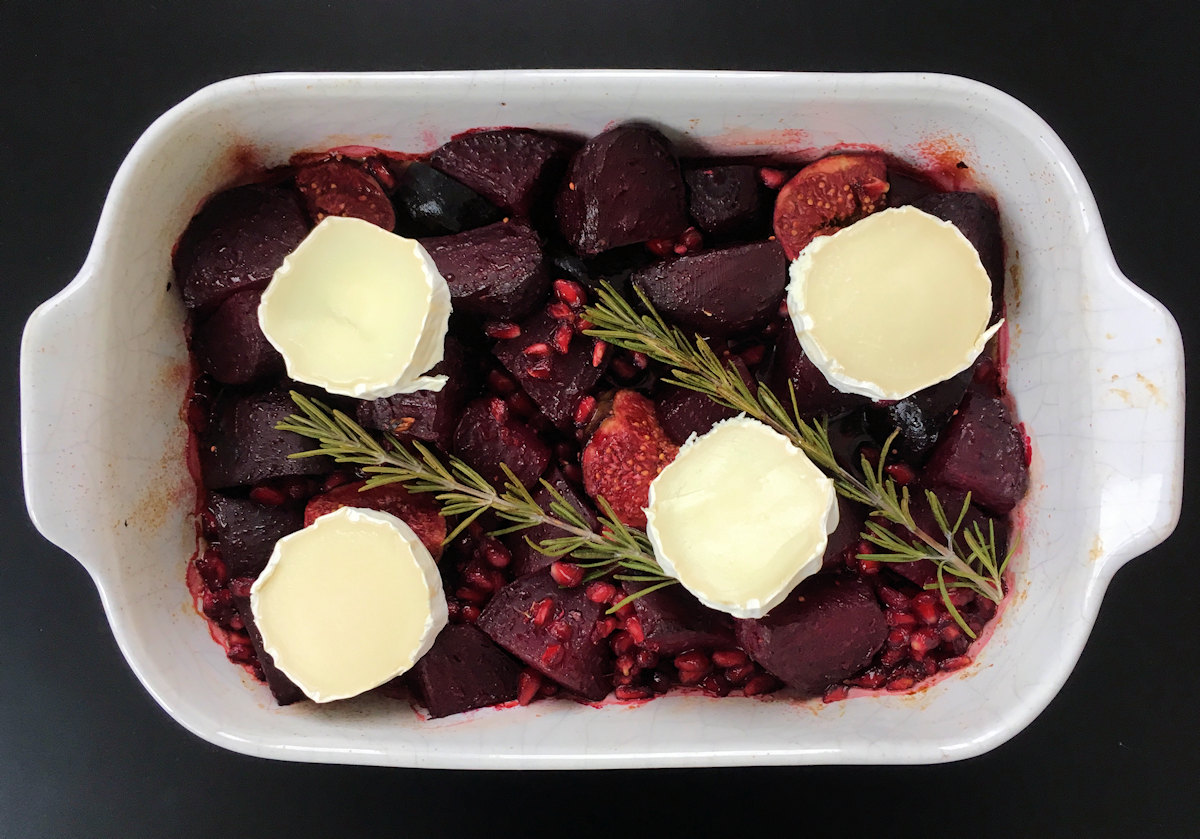Twice roasted beetroot with figs and pomegranate is crimson central: a dish of red, red and more red, suitable for the season of flaming gold and red on the trees, and misty mornings.

Ruby, scarlet and vermillion
Beetroots and figs and pomegranate – what an autumnal combination! Even though these days you can get them all the year round but figs and pomegranates are decidedly at their best from September to December. And when in season, they are the cheapest as well which in the case of the pomegranates counts a lot if you buy them from supermarkets rather than an ethnic market stall.
The dish of the three reddest foods of all is great to look at, but not so great to prepare: the kitchen does resemble the Red Wedding scene. That’s why gloves are handy when preparing the red trio, and have lots of paper towels at hand.
How to cook beetroot
Beetroots are easy to cook which is why the ready-cooked ones in supermarkets always puzzle me. There are no ready-cooked carrots or swedes so why beetroot?
The only explanation I can think of is the mess and staining everything red, as mentioned. Still, freshly cooked is always better than vacuum-packed, stains or no stains.
They are the best roasted, trimmed but not excessively and wrapped in aluminium foil. Depending on the size, they’ll take around an hour to soften – but that cooking activity is completely hands-off.
Hands-on and gloves-on is when they’ve cooled down and need to be peeled which is easy if you’re gloved. And if you’ve roasted a batch, you can keep them in a sealed food bag in the fridge to use when needed.
Pomegranate – seeds? kernels? arils?
The purple jewel-like edible seeds of pomegranate are called arils, and they are quite fun to extract.
Various methods live online including underwater extraction, but whacking halves of the fruit for the arils to pop out is the most fun.
Fig season
Figs are in season in the UK about the same time as best pomegranates so it’s handy for this little dish.
The best variety are Turkish Bursas. They are delightful raw but baked here with the other crimson fellas and goats cheese, they provide wonderful sweetness.
Twice roasted beetroot dish
The assembly is very simple: beetroot, peeled and quartered or cut into roughly bite-sized chunks combined with fig quarters and pomegranate arils go into a lightly greased dish. It needs to be seasoned quite aggressively with salt and pepper as beetroot is bland. Balsamic vinegar, good olive oil and rosemary sprigs will finish the job.
After the second (in case of the beetroot) roasting of about half an hour, it’s ready to be served, dotted with slices of good goats cheese.
Option: bake it with the cheese if that sounds more appealing. Also, swap the goats cheese for Camembert if you’re so inclined.
More beetroot recipes
Beetroot gratin, thinly sliced beets baked in garlic and dill infused cream is a gorgeous side to a fish course. No need to pre-cook the beetroot.
Roasted beetroot casserole with honey, thyme and balsamic. Cooking fresh beetroot can't be easier: as long as possible and seasoned with gutsy flavours. My balsamic thyme beetroot is a great vegetarian dish, to serve with rice or lentils.
Mixed raw and cooked beetroot salad in a tangy dressing. As all things dark red or purple, beetroot is incredibly rich in nutrients especially when eaten raw.
More fig recipes
Saganaki is a Greek dish of anything cooked and served in a small skillet, cheese saganaki the most popular. This recipe for fried saganaki feta with caramelised figs is dead simple and makes a super tasty snack or appetiser.
Tomato and fig salad with crumbled blue cheese and balsamic dressing. Sweet figs and ripe tomatoes with a salty tang of blue cheese make up an incredible burst of flavours.
Fig and prosciutto tart with ready-rolled puff pastry takes about five minutes to prepare and twenty to bake. A divine, seasonal lunch or starter dish, best made with gorgeous Bursa figs.